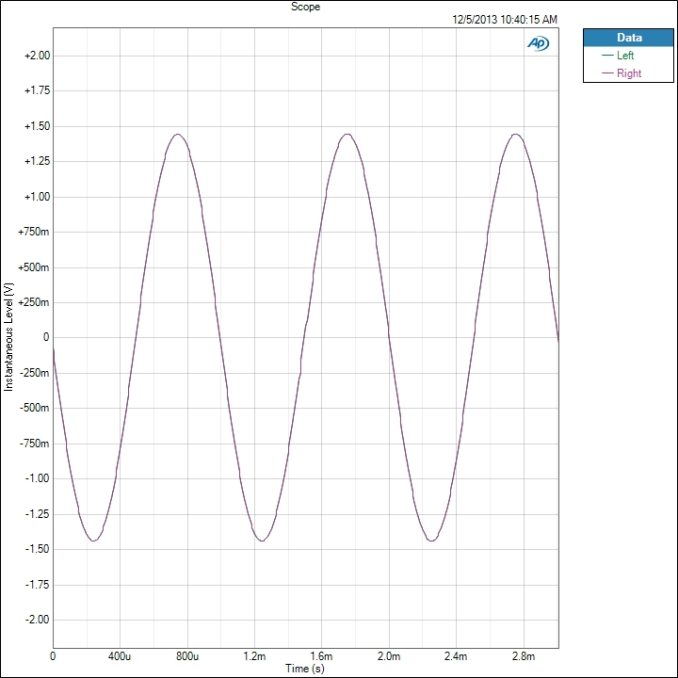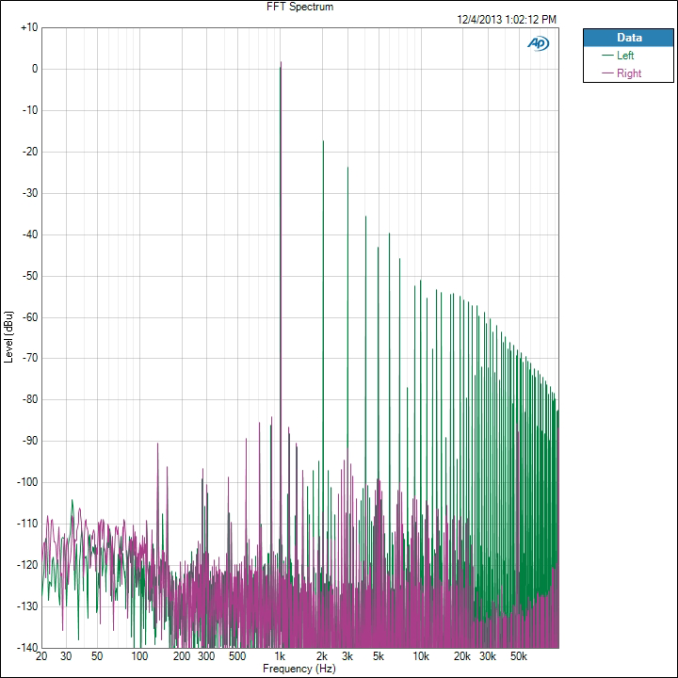Smartphone Audio Quality Testing
by Chris Heinonen on December 8, 2013 5:15 PM EST- Posted in
- Smartphones
- Audio
- Mobile
- Tablets
- Testing
THD+N is a measure of the total harmonic distortion and noise compared to the signal. The lower the number, the less distortion and noise there is relative to the fundamental frequency. THD+N is measured by driving a 1 kHz sine wave at maximum volume. Because there is always some inherent background noise, the THD+N is almost always lowest at maximum output so that is used for the measurement.
There are two results that we take from this: a sine wave and a FFT spectrum. On the sine wave both channels should line up perfectly, and it should be as close to an accurate sine wave as possible. On the FFT we want to see a peak at 1 kHz and everything else as low as possible. The most common artifact you will see are harmonic sidebands at multiples of 1 kHz.
For an example of data that looks good, here is the sine wave of the iPhone 5. We see a sine wave that is good, with channels that overlap perfectly and no deviation. This is what we expect to see.
Now for a different example we look at the Nexus 5. Run at maximum volume we see that the left channel is clipping in the sine wave. Likely the power to the headphone amplifier is not enough to drive both channels and so this is the result. UPDATE: Tested this with 4.4.1 and no change.
The iPhone 5 produces a THD+N ratio of 0.003134% while because of the clipping, the Nexus 5 is producing 13.789197%. Any level over 1% is considered to be past the clipping point of an amplifier and it seems that the Nexus 5 cannot be driven at maximum volume. I tested two samples to verify, and on both the performance is identical.
Now if we look at the FFT for this test, we see how this distortion is showing up. First, the iPhone 5 is very quiet.
There is a 2 kHz peak that is -93 dB below the fundamental frequency, and the 3rd harmonic at 3 kHz is over -109 dB below it. All the harmonics past that are at -120 dB below the fundamental tone. There is some noise out at 50 kHz but this is so far past the level of human hearing that it is safely ignored. Now the Nexus 5 FFT.
We see the right channel, which didn’t clip, looks good. The 2nd harmonic is -111 dB and the 3rd harmonic is -93 dB. On the left channel the 2nd harmonic is only -18 dB and the 3rd harmonic is -24 dB. Even at the 9th harmonic we are still only -52 dB below the fundamental tone. This is causing these incredibly high THD+N numbers that we are seeing on the Nexus 5. We will see more detail of this on a later test as well.
We also chart THD+N vs. Frequency. Here is the chart for the Note 3.
We see that THD+N is basically right below 0.08% for the whole spectrum. It moves up and down slightly, but is very constant. Now here is that Nexus 5 data.
We see that the right channel is around 0.01% THD+N while the left channel, the clipped one, is over 3%. If we ran the Nexus 5 at a lower volume level we would see totally different results, as you’ll find out later, but this is how devices are typically measured.
















188 Comments
View All Comments
ph00ny - Thursday, December 12, 2013 - link
i9100 had yamaha DAC and was dismissed by many as poor choice moving away from wolfson DAC which sounded especially great with voodoo sound. As for S3, US variants with Snapdragon did not come with Wolfson DACThe Von Matrices - Sunday, December 8, 2013 - link
I own an S3 and I hate that it's output has a bass boost profile similar to the HTC One with its "Beats" profile. It's probably great for earbuds but for any other listening device the bass is overdriven. If it just produced a flat output I would be completely happy with it.Impulses - Monday, December 9, 2013 - link
Can't it be turned off somewhere? HTC's Beats glorified EQ can be turned off and ignored entirely, well, except for the persistent notification that lets you know that it is indeed turned off (seriously).Samus - Monday, December 9, 2013 - link
A lot of custom roms try to circumvent Samsung audio layer with a combination of audio filters. Its pretty depressing...S3 owner here.speculatrix - Tuesday, December 10, 2013 - link
Xda devs is full of discussions about things like boeffla Kernel tweaks and hacks which expose more of the hardware controls of Wolfson DACs and thus allow customization of sound EQ.It does seem to be the case that you really do have to research a specific phone and all it's variants to be sure of getting the audio chain you want.
barry spock - Monday, December 9, 2013 - link
Excellent stuff. I hope you can do a showdown of the most popular phone models out there at the moment, including the iphone 5s.PrinceGaz - Monday, December 9, 2013 - link
I'd like to see iPod touch models added to the mix also, as whilst not actually a smartphone, it is in many ways very similar and music listening on it through the headphone jack is a major selling point of it. The thing is, as you don't need to hear it "ring" in a loud room, it has a much weaker internal speaker than any smartphone, so is the audio-amp driving the earphone socket as good as that of the iPhone, or have they saved money on it to hit the lower price point?Bansaku - Tuesday, December 10, 2013 - link
I too would like to see this as well. Especially between the 4th and 5th Gen. I swear the audio quality of my 4th Gen is superior to my 5th Gen. I also wonder the difference between the various models of iPhones.JoannWDean - Saturday, December 14, 2013 - link
my buddy's aunt earned 14958 dollar past week. she been working on the laptop and got a 510900 dollar home. All she did was get blessed and put into action the information leaked on this site... http://cpl.pw/OKeIJotipoo - Sunday, December 8, 2013 - link
This is perfect, I havn't read it all but I have an ancient Nexus S and it has horrendous headphone output. I've heard the next two Nexii weren't great in that either. Lots of hiss from all the radios, and even if there was no hiss there's just an odd EQ curve or something, it makes the bass muddy. I think the program Voodoo sound helped it but not completely. So audio output will be an important consideration in my next phone.